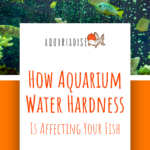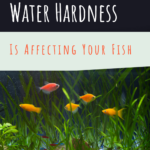While slightly less critical than pH, water hardness is an important aspect of water chemistry to understand.
In this guide, we’ll explain what water hardness is, how it affects your fish, and how you can alter it to your advantage.
Key Takeaways
- Water hardness is the measure of the amount of calcium and magnesium salts dissolved in the water. Tap water hardness varies greatly across different regions.
- Unless you wish to adjust your tap water pH, you need to choose fish that suit your local water hardness.
- By adding calcium and magnesium-rich materials to your tank, it’s possible to increase your water hardness. Hardness can be reduced by adding tannin-rich materials such as Indian almond leaves.
What Is Water Hardness?
According to greenfacts.org, water hardness is ‘a measure of the amount of calcium and magnesium salts in water.’ Other salts can increase water hardness, too, but their effects on hardness are normally negligible.
In short, the more calcium and magnesium that are dissolved, the harder the water.
Water hardness varies by geographical location – local reservoirs of freshwater can be influenced by geological composition, runoff, seasonal weather patterns, and other external factors.
How Does Water Hardness Affect My Aquarium?
General water hardness, also sometimes referred to as total hardness, is important because it is linked to water pH and acts as a sort of buffer. If you are having a problem with your pH level and either need to raise or lower it, you will first need to adjust the hardness. General water hardness should not be confused with carbonate hardness.
In terms of aquarium terminology, general hardness measures the number of minerals in the water, namely calcium and magnesium ions. These are important minerals for many fish and invertebrates in the aquarium as they help build bone and exoskeleton, regulate metabolism, and facilitate ion exchange. If fish are kept outside of their optimal hardness range, then they may not grow as big or not live as long.
How Do You Measure Water Hardness in Your Aquarium?
General hardness is usually abbreviated as GH and measured in degrees; it is common to see it notated as dGH or °GH. General hardness may also be documented in parts per million (ppm), with 1 °GH equaling 17.848 ppm.
Many commercial aquarium test kits will accurately measure general hardness as well as carbonate hardness.
Carbonate hardness (KH; also referred to as alkalinity) measures the carbonates and bicarbonates in the water, which is usually recorded as dKH or °KH.

Will Hard Water Kill Your Aquarium Fish?
Like any water parameter, if total hardness is out of the ideal range meant for your fish, then you will most likely have problems in your aquarium.
It’s important to understand the natural water conditions that fish thrive to allow their metabolism and physiological processes to work as they should without having to expend too much energy.
Certain fish species are found in certain degrees of general hardness:
Very Soft Water (0-3 °GH/0-50 ppm)
At the extreme end of the general hardness range, very soft water can be difficult to raise. There aren’t many freshwater aquarium fish that prefer this range. One notable species that fits in this range is the clown killifish/banded panchax ( Epiplatys annulatus).
Soft Water (3-6 °GH/50-100 ppm)
Most aquarium fish in this category will be from South America, where the water is naturally softened by tannins from decaying plants and other detritus. Some popular fish include tetras, angelfish, Corydoras, and South American cichlids.
Moderately Hard Water (6-12 °GH/100-200 ppm)
This range of general hardness is preferred by most species of tropical fish. This includes most livebearers, like mollies, platies, and guppies.
Hard Water (12-18 °GH/200-300 ppm)
In general, most moderately hard water aquarium species will also be able to withstand slightly harder water as long as conditions stay stable.
However, by this point, you will want to start considering lowering the general hardness or keeping African fish species that can handle the higher degrees, like congo tetras (Phenacogrammus interruptus) and African cichlids; odessa barbs (Pethia padamya), flagfish (Jordanella floridae), and some species of rainbowfish (Melanotaeniidae family) have also been known to appreciate hard water.
Very Hard Water (18+ °GH/300+ ppm)
This range is sometimes referred to as the liquid rock zone in the aquarium hobby due to how many minerals are present in the water.
While most fish can adapt to higher or lower degrees of hardness, it is always best to match the species of fish to the parameters of the tank. Most African cichlids will thrive in very hard water conditions as well, along with some cichlids from Central America.
It is important to note that these ranges are general estimations and different hobbyists might have broader or closer ranges for each category.

What Fish Do Well in Hard Water?
Most freshwater livebearers can adapt to hard water. However, once the water is considered very hard, your stocking is mostly limited to African cichlids that are endemic to the Great Lakes of East Africa.
This is because these lakes, like Lake Malawi and Lake Victoria, have rocky bottoms that keep the hardness high; some Central American cichlids also do better in hard water as opposed to soft water aquariums.
It should also be noted that most live aquatic plants can withstand a large range of general hardness. However, some hobbyists have found that certain types of algae grow better in aquariums with more extreme water parameters, leaving aquatic plants to be outcompeted.
How Do You Increase Water Hardness in Your Aquarium?
If your tap water is particularly soft, or you want to keep freshwater fish that need a little more specific water chemistry, then you will need to know how to raise the mineral content in your aquarium.
Crushed Coral and Limestone
Adding crushed coral to an area of high water flow, like the aquarium filter, is a popular method for raising both the general hardness and carbonate hardness.
Similarly, limestone may be added to the main aquarium display or to the filter to help raise both KH and GH.
Both crushed coral and limestone release minerals into the water over time which helps increase the concentrations; this also causes pH to rise respectively. The rate at which the crushed coral and limestone dissolve in your tank is largely based on how acidic the water is.
Other Aquarium-Safe Products
Some hobbyists use Epsom salt to help raise total hardness in their aquarium as it contains magnesium. However, it does not contain calcium and those levels would need to be raised otherwise.
In our opinion, Epsom salts can be difficult to dose at the correct levels and can have lasting effects on fish and invertebrates.
If you are unable to use crushed coral or limestone, it may be best to go with aquarium-safe calcium/magnesium products that are specifically designed to raise general hardness. Follow the directions provided and perform a water test regularly to safely track general hardness, carbonate hardness, and pH.
How Can You Reduce the Hardness in Your Aquarium Water?
An effective way to reduce water hardness in your aquarium is by adding tannin-rich materials like Indian almond leaves.
By releasing tannic acids, these items not only make the water softer but also lower the pH.
You can find out more about adding tannins here!
Using Reverse Osmosis Water
If you are struggling with maintaining hardness levels in your tank due to the source water being used, it might be best to switch over to distilled or reverse osmosis water.
This will be a financial investment, but can sometimes make it easier to achieve your ideal water hardness and pH.
Conclusion
Water hardness is an important aspect of aquarium water chemistry to get to grips with. By choosing an aquarium test kit that includes water hardness, you’ll know more about which types of fish you can keep, and whether you need to adjust it.













I’ve got a 90 litre tank with mainly platies and amano shrimp, plus 1 golden barb. My GH is 120 ppm, KH 40 ppm, PH 6.0 PH, low nitrate and nitrite. I’m confused as with these parameters I seem to lose fish once every 6 months approx plus I don’t see my platies getting pregnant (they’re 2 males to 4 females)
Any ideas?
Hey Melisha,
I would say that 1 fish every 6 months is pretty normal. Especially with platies, they’re bred fast and not in the best conditions so there are probably some underlying issues. As to why they might not be mating is another problem. Try doing more water changes and giving a more protein-rich diet. You could also up your ratio to 6 females and 2 males.
Hi
In my cold water tank the general hardness is 180. Can I get anything to bring this down please.
Hey Brian!
180 ppm isn’t terribly high and I think most fish would be able to adapt to these conditions. If you’re really concerned though, the most controlled method would be mixing the water you’re using with reverse osmosis water. That’s really the only efficient way.
Yeah it’s so weird my ph was 7 and my gh use to be 30 my kh 80 now I guess because of the drought well water its ph 6 gh 0 kh 40 . I’m getting argonite to put in my aquarium but I don’t know how much to use . It’s going to be for a crayfish from the creek in virginia . I have a 10 gallon set up 1/2 with water so he will be able to crawl out with stones that are safe a hang on the back water filter a bubbler water spangles moss and red water sprite . I know he will kill the plants but I have more in the other aquariums . The filter was cycled from another tank and has been running a month . I put some of water from tanks I clean every Friday so plants have food nitrates and nitrites are 0 .
You will want some nitrates in your tank if you’re planning on keeping live plants for long! Your crayfish should help dirty the water a little bit, but you definitely want to have traceable amounts of nitrate (not nitrite) available.
As for the pH.. that change from 7.0 to 6.0 is pretty significant. pH is a logarithmic scale so that was 10X a bigger change than it might look according to the numbers. For now, it might be best to buy purified water from the store or start raising pH before you put it into the tank.